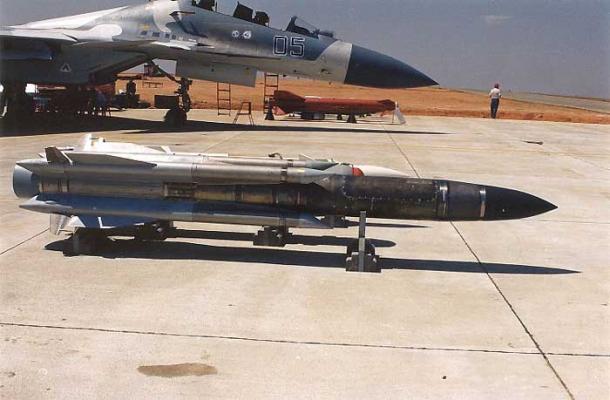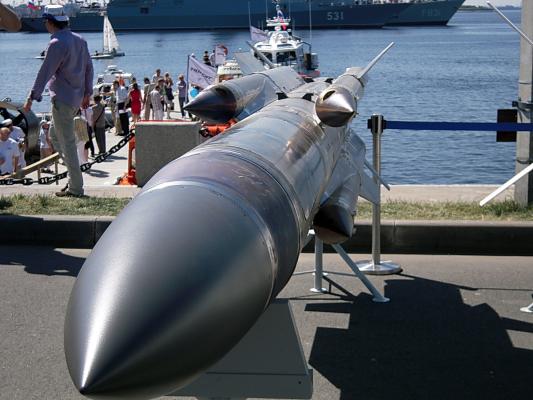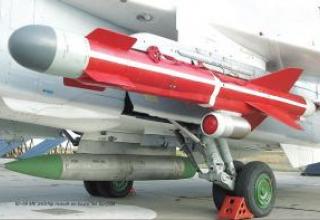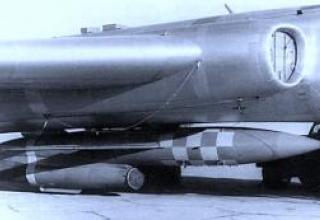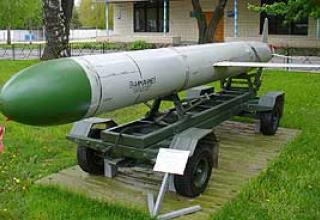The X-31A tactical anti-ship supersonic aircraft missile is designed to engage combat surface ships of various classes up to and including the destroyer, with a displacement of up to 4,500 (8,000) tons, as well as landing and transport vessels traveling alone or in convoys.
X-31A can be used practically from any carrier aircraft on which a container can be suspended or which has an onboard target designation system with a range of more than 50 km. JSC "Concern Radio Electronic Technology" in 2015. reported the possibility of placing the X-31 missile on board the deck version of the helicopter Ka-52K in the case of modernization of the onboard radar. This will increase the range of target detection by helicopter in 2 times, which is almost 200 km.
The missile was created at the Zvezda Design Bureau under the leadership of Chief Designer G.I.Khokhlov on the basis of X-31P antiradar missile. It was first demonstrated in 1991 at the aviation exhibition in Dubai, UAE.
At present, a high-speed anti-ship missile Kh-31AD is created on the basis of Kh-31A (see photo 1, photo 2, photo 3, photo 4, photo 5). The X-31AD differs from its prototype by a much longer launch range (up to 120-160 km) and a 15% increase in combat unit capacity. The carriers of the X-31AD are Su-30MK (MKI, MKM, MK2), Su-35, MiG-29K, MiG-29KUB, MiG-35 and others.
In the west, the missile was designated AS-17 "Kripton".
Composition:
Missiles X-31A (X-31AD) (see projections) are made by the normal aerodynamic scheme with an X-shaped arrangement of the wing and rudders. The missile consists of three compartments. Each compartment is a structurally and functionally complete unit. Four side round supersonic air intakes are located on the hull in the plane of the bearing surfaces.
The engine is a direct-flow air jet, created in MKB "Soyuz" (Turaevo, Moscow region) . It consists of: air intakes, fuel tanks with displacement system and fuel dosing equipment, front-end device, combustion chamber with unregulated supersonic nozzle, electrohydraulic system of combustion control.
The combustion chamber of the marching engine accommodates a solid fuel launch accelerator, which after separation of the rocket from the launch vehicle reliably ensures its acceleration to the launch speed of the marching SARD. After operation is complete, the booster is pushed out by a racing air stream. The use of such an integrated propulsion system provides an increase in the average speed and range of firing while reducing the size of the missile.
The X-31A family of missiles operates in conjunction with the sighting and navigation system and weapon control system, which are part of the on-board equipment of the aircraft carrier.
The missile can be used in two modes:
- combined with target acquisition by auto-actuation of the CNS under the hover of a carrier aircraft
- autonomous with the capture of the target to autocompany CNS on the trajectory of the missile (after launch) at a distance of 7 ... 20 km from the target.
The mode is selected by the carrier crew depending on the flight height and target detection range. After the carrier radar crosshairs are superimposed on the target mark and the corresponding commands are given, the calculation of the permitted launch zone starts and the information is given to the rocket to prepare it for launch. Then there is the preparation of the missile circuits for launch, data entry of target designation and flight parameters of the carrier aircraft in the rocket. When the aircraft in the zone of possible launches (see diagram for X-31A), the operator sends a signal from the board "launch" to the catapult device and is ejected one of the missiles. After launch, the rocket performs an autonomous flight in accordance with the selected laws of control in the area of target search. The estimated point of exit of the missile in the target acquisition area of the active radar homing head (ARGSN) is at a distance of 7.5 km from the target at an altitude of 100 m. After capturing the target, the missile makes a "jump", which excludes the possibility of the missile driving when approaching the target with small angles.
The target is defeated by detonating the warhead of the missile after penetrating it into the ship in a direct hit, or by shattering it as the missile flies over the target. Launch of X-31A from the aircraft carrier is possible on the target located within ± 8 ° course angles.
X-31A (X-31AD) missiles can be used day and night, with sea disturbance up to 4-5 points and in any weather conditions, with active radio-electronic and fire counteraction of the enemy against targets with pre-defined coordinates, as well as detected by the aircraft radar during the flight (the main method).
The average required number of hits of X-31AD missile to hit a target such as "destroyer" - 2, for a target such as "missile boat" - 1.
For transportation and storage of the missile is used sealed container.
Characteristics:
| Х-31А | Х-31АD | |
| Range, km: - maximum target range of the destroyer type with a launch height of 15 km - maximum target-specific destroyer with a starting height of 10 km - target missiles - minimum |
70 50 25 5-7 |
120-160 - - - |
| Flight Speed, m/s: - maximum - middle |
1000 600-700 |
|
| Flying speed of the carrier, km/h | 600-1250 | |
| Launch height, km | 0.1-15 | |
| Dimensions, mm: - length - maximum housing diameter - wingspan - steering wheel range |
4700 360 778 914 |
5340 360 - 954 |
| Start weight , kg | 610 | 715 |
| Weight of combat unit, kg | 90-95,9 | 110 |
| Active radar CNS ARS-31 | ||
| Azimuth angle, deg | ±27 | |
| Vertical viewing angle, deg | between +10 and -20 | |
| Weight, kg | 39 | |
| Diameter, mm | 360 | |
| Length, mm | 1012 | |
| Temperature of use | between -50° and +50°С | |
| Aviation launcher AKU-58 | ||
| Developer | Vimpel ICB | |
| Weight of empty PU, kg | 185 | |
| Dimensions, mm: - length - width - altitude |
3810 130 220 |
|
Testing:
On the basis of PKR X-31A by the enterprise "Star - Arrow" was created target rocket M-31. This product was the first Russian aircraft missile to be sold in the USA. M-31 won the tender organized by the US ILC command and in 1996 it was purchased through Boeing. The purchase price was $4.7 million.
Tests were conducted at the US Marine Corps Point Mugu range, and were conducted from aboard the F-4J Phantom II aircraft equipped with a Soviet-made AKU-58 catapult device. The first launch was made at an altitude of 300 m, then the UR was reduced to 20 m and passed, maneuvering, about 30 km, after which the tracking radar was lost. According to available data, none of the missiles of the first batch was shot down. Then the KMP purchased two more batches of targets. According to a representative of the company "Star - Arrow," their tests were already held in secrecy and the company was not only unable to send their specialists to the U.S. range, but also did not receive specific information on the results of tests. In his opinion, the Americans do not yet have effective protection against supersonic small-size PCR.
Sources:
- А.В.Карпенко, С.М. Ганин "Отечественные авиационные тактические ракеты", "Бастион" N1, 2000г
